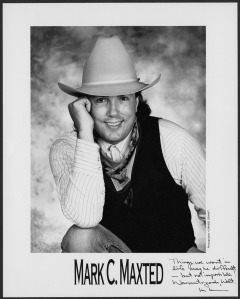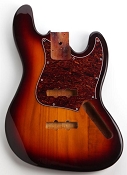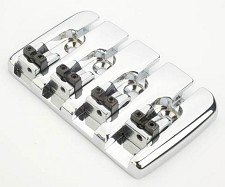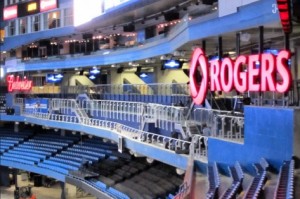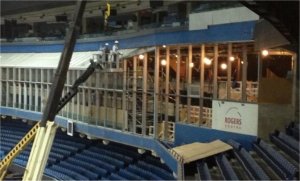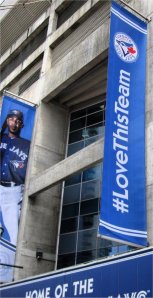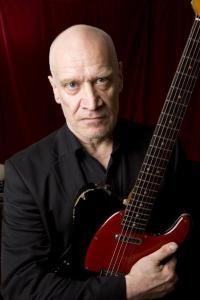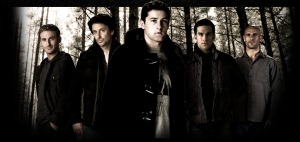“I don’t know. I’ve never smoked the stuff”. – Tug McGraw, on artificial grass.
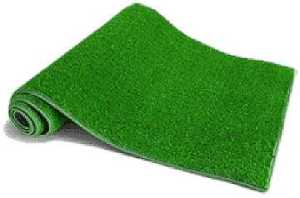 Just before the baseball season began, I happened across an interview with Paul Beeston on TV. One of the topics, which has been discussed for a couple of years now, was replacing the artificial turf in the Rogers Centre with real grass which, Beeston assured us, was contemplated “for either the 2015 or 2016 season”.
Just before the baseball season began, I happened across an interview with Paul Beeston on TV. One of the topics, which has been discussed for a couple of years now, was replacing the artificial turf in the Rogers Centre with real grass which, Beeston assured us, was contemplated “for either the 2015 or 2016 season”.
I reflected on this a little bit, and realized that the SkyDome (as it was called when it was built) and the Florida Suncoast Dome (as it was called when it was built) are the only two Major League ballparks that still have an artifical playing surface. Of course, the FSD is now better known as Tropicana Field, home of the Tampa Bay Rays.
This is particularly amazing when you consider that every single Major League ballpark built between 1970 and 1991 was constructed with an artifical playing surface. Though that might seem like sacrilege from this perspective, you have to remember that this was the first generation of modern sports stadiums (I’m pretty sure the Colosseum in Rome was publicly funded) which were built with taxpayer’s money. Prior to that, each team owned its own ballpark.
With the enormous (or so it seemed at the time) public expenditure involved, each building had to be an all-purpose facility that could be utilized up to 200 mights a year; housing not just 81 baseball home games, but the local NFL team, and rock concerts, and tractor pulls, and politcal conventions, and whatever other use local promoters could dream up.Thus, the justification for using an artificial surface was essentially, “we need to be able to switch quickly between events, and having a playing surface you can swap out is the only way to do that”.
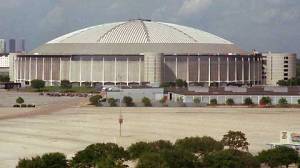
The Astrodome
The history of artificial turf is roughly thus: when Major League Baseball expanded to South Texas in 1962, it discovered that Texas heat and ravenous insects weren’t conducive to the grand pastoral game – more than once, a game had to be called on account of bugs. Judge Ray Hofheinz, the team’s principal owner, had an answer in his back pocket – the Harris County Domed Stadium. Move the game indoors (R. Buckminster Fuller had already assured Hofheinz that you could enclose an area the size of a ballpark, “provided you didn’t run out of money”), crank up the a/c , and “Play ball!”.
They installed a sprinkler system for the turf, and placed Lucite panels in the ceiling to let in sunlight. However, when it became apparent from the first game that the clear panels made flyballs impossible to see, they were painted over. As the paint dried, the grass died.
Assistant GM Tal Smith was sent to find a solution. Monsanto, as it turned out, had been working on an artificial playing surface for some time, intending it to be used for high school and college fields; institutions who couldn’t afford to resod their grass fields after every rainy, muddy game. A deal was struck; the team got their turf and, in exchange, Monsanto got the free publicity. Because Houston was home to NASA’s Mission Control Center, and everyone in the US was space-struck at the time, the team (originally the Colt .45’s) became the Astros, the Harris County stadium became the Astrodome, and Monsanto’s fake grass became AstroTurf.
Then the dominoes started to fall; new facilities in Pittsburgh, Philadelphia, Kansas City, Montreal, Cincinnati, Minneapolis, Seattle, San Diego, St. Louis & Toronto all had artificial turf. It changed the way the game was played – speed became king. Punch-and-Judy hitters learned that they could chop the ball off the infield and leg out a base hit; infielders learned that they could skip the ball off the turf on a throw to first and actually get it there quicker.
Incidentally, this is why I get such a chuckle out of people who say, “I’m a baseball purist. I like natural grass. And bunts. And stolen bases. And the hit and run.” The running game was one helluva lot more of a sound strategy on AstroTurf. If you like natural grass, you should like the Earl Weaver brand of baseball – pitching, defense and the three-run home run!
One other oft-ignored point about artificial turf is that it does nothing for the comfort of the occupants of the stadium. Aside from the injury concerns of players working on what is essentially thinly-carpeted concrete, it’s no better for the fans. On a hot day, natural grass will absorb the CO₂ exhaled by the fans and release cooling oxygen into the atmosphere. Artificial turf just acts like a giant mirror and reflects the heat back into the stands.
Ballparks built in the early part of 20th century were mostly retired in the late 50’s and early 60’s, having a lifespan of around 50 years. The AstroTurf generation started to be replaced in the early part of this century, sometimes barely 30 years after construction. And, of course, now that they’d had a taste of public money, it was very difficult to wean teams away from the teat – they were a “public institution” (albeit privately owned), after all, and a source of civic pride.
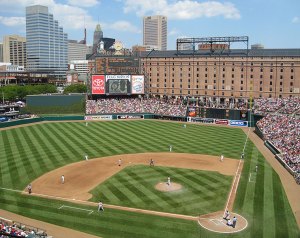
Camden Yards
Was it of necessity that teams needed new ballparks, or was it fashion? In the 70’s, new ballparks were moving to the suburbs, following the fans. In the late 80’s, starting with SkyDome, stadia started moving back downtown, becoming centerpieces of urban renewal projects. Then Camden Yards in Baltimore came along, and the floodgates opened; every team had to have a retro-style ballpark, with modern amenities, right downtown. The public funding was usually disguised in the form of a lottery or consumption tax (hotel taxes were popular – locals don’t stay in downtown hotels, right? Let the out-of-towners pay for it).
So what of the three remaining turf-era ballparks? Kansas City got real grass in 1995, courtesy of legendary Superbowl groundskeeper George Toma. That leaves the two domes. The Trop is, I think, stuck with an artificial surface – the roof doesn’t open, and even with the best team in the AL East, they don’t draw enough fans to convince anyone to build them a new ballpark; besides, the building they play in is barely 20 years old. So, the Rogers Centre is it; the last turf park that doesn’t need to be. Let’s hope it changes. Soon.
